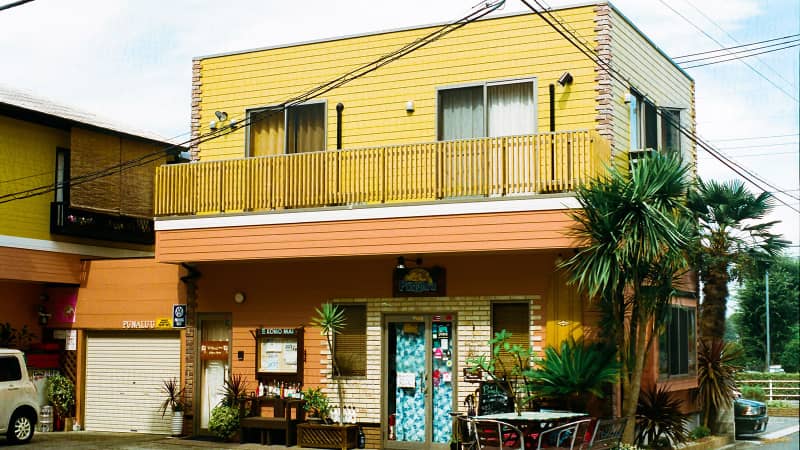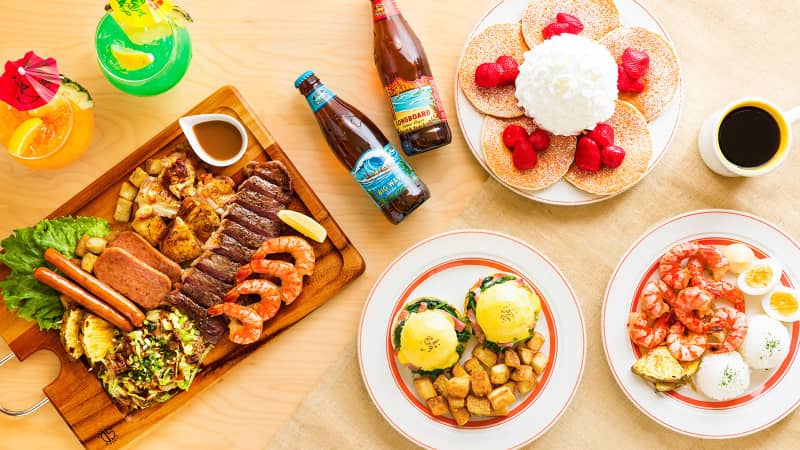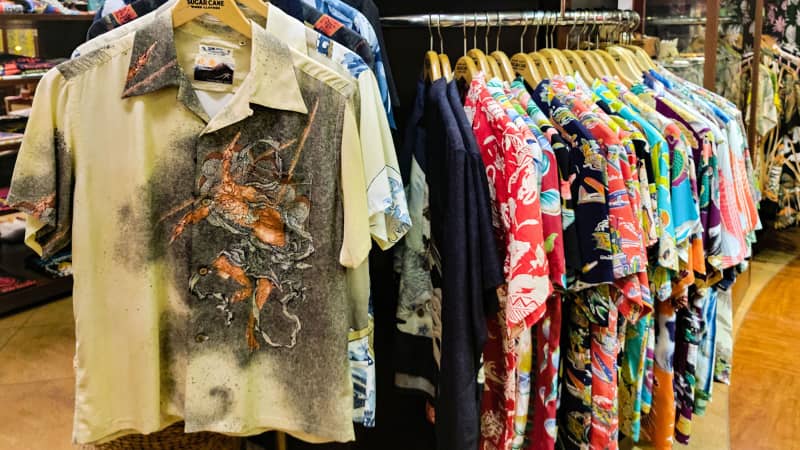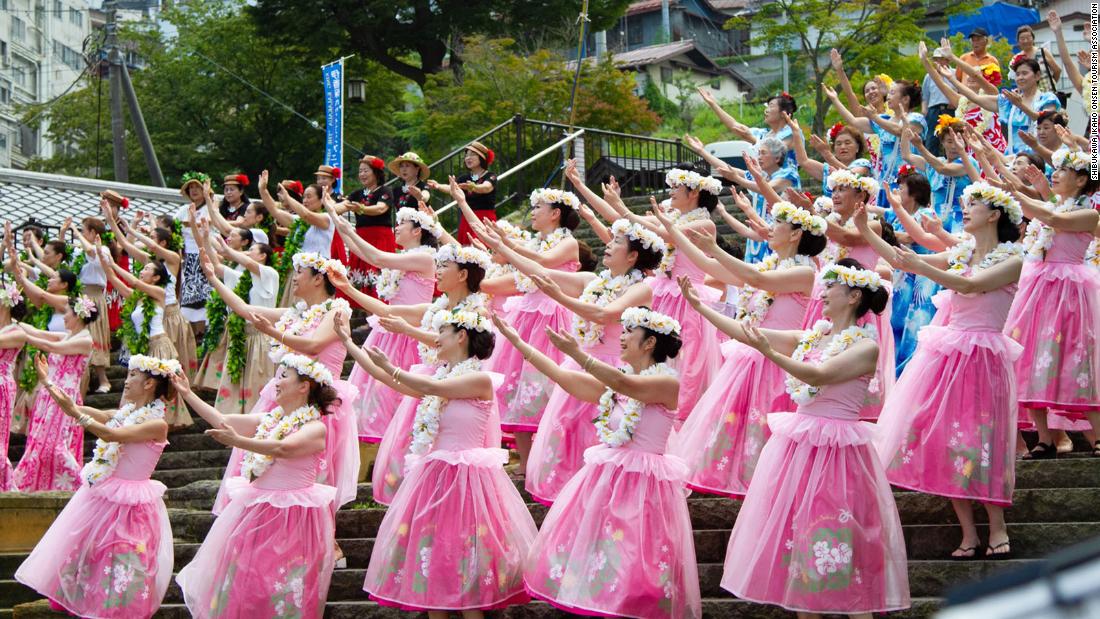(CNN) — Hawaii is consistently one of the most popular holiday destinations for Japanese tourists. But they don’t show their love just by going there.
Food, clothes and even festivals all over Japan demonstrate that people’s love for the islands is about way more than beaches.
According to a 2022 travel trend report from Japanese domestic travel agency HIS, Hawaii had the most overseas trip reservations for the summer holidays, accounting for 20% of people booking overseas summer trips through the agency.
Japan’s two biggest airlines, ANA and JAL, restarted their daily flights to Hawaii in July and June, respectively, for the first time since the pandemic.
“ANA and JAL know that Hawaii is the first place Japanese tourists return to when traveling abroad. It is a place where they can go freely without a visa,” said Kotaro Toriumi, a Japanese aviation and travel analyst. “These airlines are strengthening their Hawaii campaigns the most … all they do is advertise for trips to Hawaii.”
Japan’s love affair with Hawaii can perhaps be summed up by one word: iyashi. It means “healing” or “comfort” in English but often encapsulates the sense of freedom and relaxation that many Japanese associate with the islands.
Rise in popularity, rise in prices
Although Japanese travelers’ love for Hawaii goes back decades, it will take a while for travel numbers to go back to their pre-Covid-19 heights.
Before the pandemic, Japanese travelers made up the largest number of overseas tourists in Hawaii. Based on data from the Hawaii Tourism Agency, Japanese tourists also spent the largest amount of money per visitor.
The number of travelers from Japan dropped by 95.2% for the first half of 2022 with only 34,925 visitors compared to the 734,235 in 2019. Japanese tourists spent $86.7 million in the first half of 2022, dropping 91.6% from $1.03 billion in 2019, just in Hawaii.
And there’s another factor at play, which is the decline of the yen. It has become much more expensive for Japanese to travel to the U.S. due to the yen’s decline against the dollar. The majority of current flight reservations for Hawaii are for upper cabin classes like business and premium economy.
“The people who want to go now are mostly wealthy people or people with high salaries because it’s normal for them. I think it’s not possible for young people to casually go to Hawaii right now.” Toriumi added.
Experiencing Hawaii without leaving Japan
For those who are unable to go to Hawaii, Japan offers local options.
Hawaiian-themed festivals — with hula dancers, ukulele players and Hawaiian food trucks — are extremely popular.
These festivals are in metropolitan cities like Tokyo, Yokohama and Osaka, as well as rural areas like Ikaho Onsen, a hot spring town in Gunma Prefecture.
“I thought (these festivals) would lead to bringing that kind of Hawaiian culture to Japan and letting people know about the goodness of Hawaii.”

Punalu’u is painted yellow to remind visitors of sunny Hawaiian skies.
Kathleen Benoza
Beyond recurring festivals, there are Hawaiian restaurants all over Japan.
Punalu’u, a homey Hawaiian-themed restaurant in Yachiyo, Chiba, is adorned with a variety of both broadly American and Hawaiian-specific memorabilia. There’s a Harley Davidson motorcycle as its centerpiece by the wall and a surfboard above it with the store’s name.
The owner and chef, Yuji Nonaka, 57, quit his salaryman job and started his restaurant 14 years ago with his wife, Kiyomi Nonaka, 50.
Kiyomi discovered her love for Hawaii — particularly hula dancing — during a work trip as an 18-year-old.
“Hula helped me get through so many things in life, whether it be with my relationships with others or if something didn’t go well at work. When I do hula, it feels like I’m in a higher dimension. I wanted to share this feeling with others, so I opened up my own hula school here 18 years ago,” she said.
A common misconception about hula is that it’s a dance tradition strictly for women. Nope. In ancient Hawai’i, men were the first to dance hula, and the best dancers were even chosen to become warriors. Today, Ke Kai O Kahiki—one of Hawai’i’s most famous male hula schools—is carrying on this tradition by telling warrior stories with dance. To do so, dancers train in the same way as their ancient forbearers, using the land itself as a harsh and unforgiving gym. To dance like a warrior, you need to train like one.
The roots of a relationship
Yujin Yaguchi, a professor at the University of Tokyo’s Graduate School of Interdisciplinary Studies, focuses on Hawaii and U.S.-Japan cultural relations.
Yaguchi notes that at the beginning of the 19th century, a large number of Japanese immigrated to Hawaii, which made it a familiar and easy place for Japanese tourists to travel to.
Many had relatives they were visiting, and it also helped with the language barrier.
Data from the American Community Survey done by the U.S. Census Bureau indicated in a 2016-2020 study that 22.3% of Hawaii residents identified as Japanese or part-Japanese.
“Today, I think people (in Hawaii) speak Japanese for business purposes. It’s very easy to access people who are capable of understanding, if not speaking, Japanese, and you’ve got announcements and signage and everything in Japanese,” explains Yaguchi.
For nearly 20 years after the end of World War II, leisure trips abroad were banned in Japan, with occasional exceptions for study abroad programs or business trips.

Spa Resort Hawaiians was the first Hawaiian-style resort in Japan.
Spa Resort Hawaiians
“Pleasure travel was not allowed for almost two decades after the end of the war. The war ended in 1945 and foreign travel was heavily restricted until 1964, but once the travel ban was lifted, Hawaii was one of the most popular places for the Japanese to visit,” Yaguchi further adds.
Even if they couldn’t go, they dreamed of Hawaii.
Spa Resort Hawaiians is a hot spring theme park located in the Joban area of Fukushima Prefecture and was the epitome of a simulated Hawaii in the following years after the ban.
As the coal industry deteriorated in the 1960s, the local mining company transitioned into tourism to help save jobs and resuscitate the local economy, creating the first resort facility in Japan, with a heated swimming pool, palm trees and even entertainers from Hawaii.
The rise of the value of the yen along with the Japanese economy in the 1980s gave Japanese the affordability to visit Hawaii into the 1990s, at the height of the bubble economy.
“Hawaii kind of became a beach paradise and also a shopping paradise for the Japanese in the 1990s,” said Yaguchi. “Then there’s this kind of reformulation or re-conceptualization of Hawaii as not so much a shopping paradise (but more of) as a kind of place for iyashi.”

The owner of Da Plate Lunch 808 wanted to create a plate lunch restautant in Japan like the ones he visited in Hawaii.
Kathleen Benoza
Peace on a plate
A plate lunch is a product of Hawaii’s multicultural background. Usually, it’s two scoops of white rice, a side of macaroni salad with a generous portion of mayonnaise and your choice of protein, commonly doused with thick savory gravy.
“When I went to Hawaii and saw plate lunches, I found it fascinating. It was a fusion of American, Japanese and just of Asian (cultures). That was really interesting to me and so that got me addicted to plate lunches. I realized that there weren’t many plate lunch restaurants in Japan that were close to what I was having in Hawaii,” said Akihiro Misono, who started his plate lunch restaurant Da Plate Lunch 808 in Sakura, Chiba Prefecture, last year.
The Honolulu-based radio station KSSK-FM is transmitted from Hawaii into the restaurant. Customers often sport “aloha shirts,” which are called Hawaiian shirts in the U.S.
Eggs ‘n Things, a breakfast cafe and restaurant chain based in Hawaii, only has overseas locations in Japan. The first one opened in Harajuku in 2010.
Kota Matsuda, CEO of Eggs ‘n Things Japan, cited the popularity of the brand among Japanese travelers who visited Hawaii.
“Especially in these difficult times of Covid, for many people, the barriers to travel overseas are still high. We give our customers that want to travel to Hawaii but can’t quite yet, the experience closest to being there. People come here not just for the Hawaiian-style food but also the unique ‘Hawaiian Vibe,'” Matsuda said.

Eggs ‘N Things is a Hawaiian breakfast chain with a huge Japanese following.
Kota Matsuda
Wearing your fandom
Yosuke “Yo-chan” Seki, aloha shirt enthusiast and driver, surfs every weekend and never gets tired of going back to Hawaii — he has been going every year since 2011.
“Ever since I started wearing aloha shirts, I’ve mostly been wearing them in my daily life,” said the 47-year-old. “I hope that people look at me wearing them and think that they want to try wearing them too. Right now, I’m wearing a replica of one of the expensive designs that can cost up to around several million. The one I’m wearing is around 20,000 to 30,000 yen.”
Forty-year-old Asami Seki, also an aloha shirt aficionado, owns an accessory business called 82 of aloha. A year ago, she started creating hypoallergenic accessories people can wear as they surf.
“I’ve only been to Hawaii once, but during this time, even when I’m not able to go because of the pandemic, I’ve come to gradually love Hawaii more and more,” she said.
“I always wanted to go to Hawaii and have always admired it even before I first visited. After I came back from my first trip, I started including aspects of Hawaii into my lifestyle.”
Her husband, Yosuke, agrees with that sentiment: “It’s become a type of status for me.”

Hawaiian shirts are known as “aloha shirts” in Japan.
Kathleen Benoza
“When I want to dress up, I wear aloha shirts. I feel like I’ve dressed sharply when I wear them and it’s really exciting to pick out a theme for the day and coordinate with others accordingly, ” added Asami.
The shirts are heavily influenced by Japanese artistry and designs.
Sun Surf, an aloha shirt brand under Toyo Enterprise with about 50 years in the game, focuses on reproducing aloha shirts from the 1930s -1950s. Its brand director, Yoshihiro Nakano, 47, is an aloha shirt researcher who started collecting the shirts when he was a teenager.
According to Nakano, aloha shirts began with Japanese immigrants in Hawaii.
“They dressed in Japanese-style clothing even in Hawaii. In the latter half of the 1800s, there were people who immigrated to Japan, and shortly after that, they started importing rolls of fabric, among them Japanese clothing. The locals saw that and thought it would be interesting to make shirts using them, so they started making aloha shirts with Japanese patterns,” said Nakano.
Mass-market production began after that. Instead of importing rolls of fabric for Japanese clothing from Japan, stores in Hawaii imported a wide variety of printed fabric just for aloha shirts.
Today, these aloha shirts are also considered collectors’ items.
“There are many (customers) that never wear (the shirts) and just collect them or frame them,” Nakano shared.
It’s all in the spirit of iyashi.
